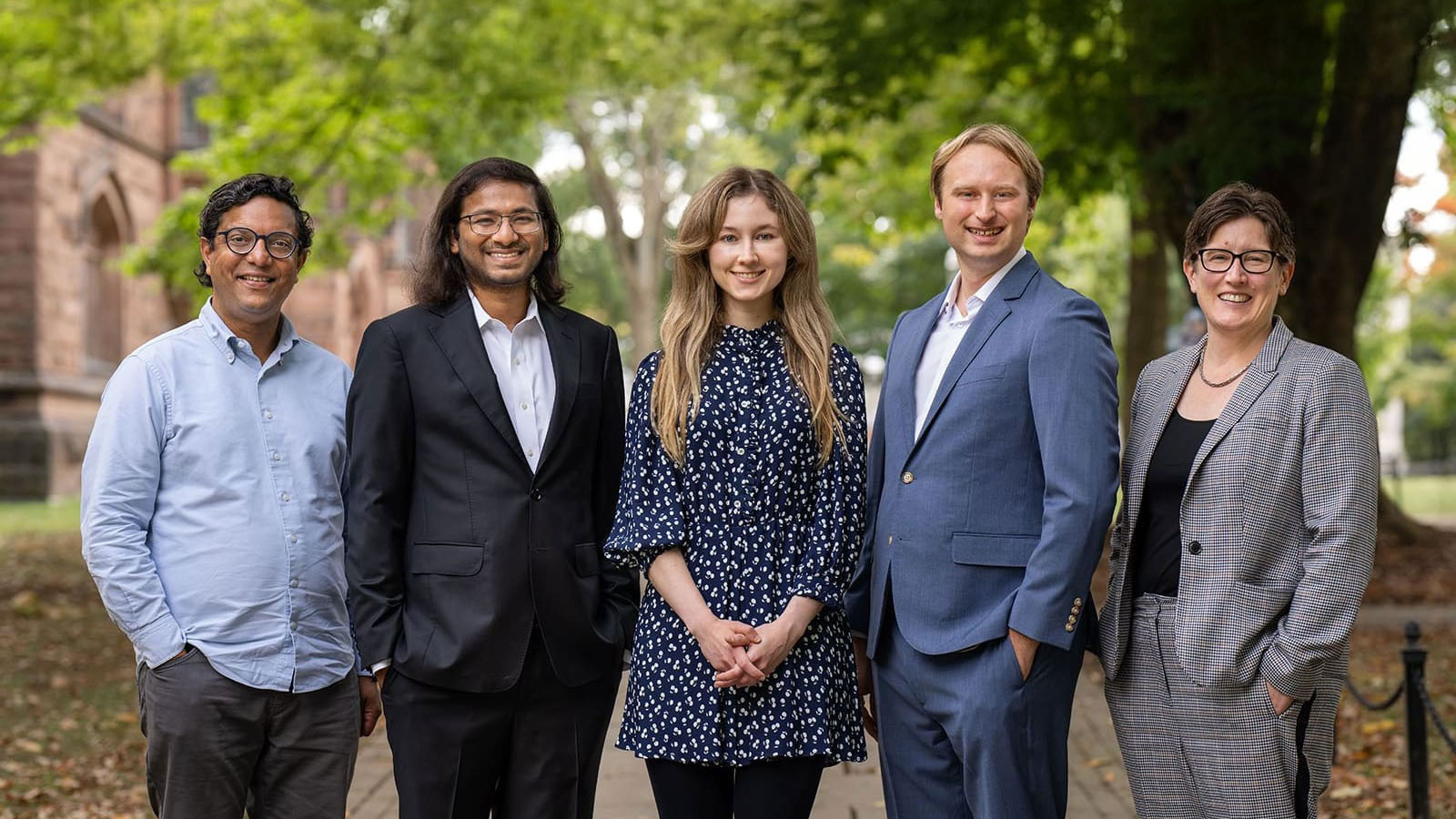
The Early Years: A Few Questions and Answers
By
on
This is from the series E100: Princeton Engineering’s 100th anniversary
In Part One of #100Years100Facts, we learn about the founding of the School of Engineering, the people who took the initiative to give engineering a home of its own at Princeton, and some of our first faculty who left a lasting mark on society.
Follow the latest stories on our Instagram account.
Welcome to our yearlong celebration of Princeton Engineering’s centennial year!
In honor of #PrincetonE100, we are presenting 100 facts about the people, places, discoveries and milestones that have made us who we are. Here’s the first fact. When was the School of Engineering founded?
That’s easy — 100 years ago, in 1921.
One hundred years ago, Princeton University announced the formation of a School of Engineering, building on two programs that date back nearly another half century.
The first engineering department was civil, founded in 1875 by engineer and applied mathematician Charles McMillan. The second was electrical, developed in 1889 by physicist Cyrus Fogg Brackett. The newly formed school soon added three more departments: mechanical, chemical and mining.
The names and focus areas of departments changed over the century, but the core idea has remained the same: Build on Princeton’s unique strengths to put science in the service of society.
This is fact #1 of 100 facts to celebrate Princeton Engineering’s 100th anniversary!
Which former chairman of the civil engineering department was best known for inventing a way to stress test bridges, dams and other structures?
In 1933, this fellow famously made and tested a steel model of a Golden Gate Bridge tower, built at a scale of 1:56, reporting his results that the bridge was sound. He was a forerunner of such Princeton Engineering faculty as David Billington and Maria Garlock.
It was George E. Beggs, a Princeton civil engineering professor, is shown here working on a model of the proposed Camden-Philadelphia tunnel in 1935. His work on the Golden Gate Bridge tower project, along with Elmer K. Timby, demonstrated the bridge was sound.
According to his obituary in The New York Times, Beggs was known for building scale models of proposed structures out of celluloid, adding test weights and using his own instruments to measure the impact. These gauges “were so delicate that they would record the strain on a brick wall when a man leaned against it.” He died in 1939 at the age of 56. One of the six units of the EQuad, Beggs Hall, is named for him. (The Camden-Philadelphia tunnel plan, delayed by World War II, was ultimately rejected in favor of the Walt Whitman Bridge.)
Today, our Department of Civil and Environmental Engineering is a world-leading program in not just designing innovative structures but revealing the role that iconic structures have played in the development of society. The late professor David Billington ’50 engaged thousands of Princeton undergraduates in his iconic courses that used bridges and other structures to “bridge” engineering and the liberal arts.
Today Maria Garlock, Sigrid Adriaenssens and Branko Glisic are leaders in this area. This is the third of 100 facts to celebrate Princeton Engineering’s 100th anniversary! Image courtesy Princeton Alumni Weekly.
Before the School of Engineering was created, it existed in two departments, civil and electrical engineering, under the umbrella of the School of Science.
An outside group of alumni was instrumental in pushing to give engineering a larger presence on campus. In 1913, the group met with the university’s president, John Hibben, at the Princeton Club in New York to discuss the possibility of creating a larger, freestanding School of Engineering, which came to fruition after World War I in 1921. What was the name of this alumni group?
It was the Princeton Engineering Association, formed in 1912 by the growing number of alumni of Princeton’s first two engineering programs in civil and electrical engineering. These alumni appreciated the unique education they had received and were eager for the University to include more branches of engineering. It was a fitting beginning: faculty in engineering have a long history of mentoring their students to lead in their professions; the alumni in turn have been a critical part in advocating for and helping grow the school. These hundreds of alumni in the association included Wilbur C. Fisk, an 1890 graduate of Princeton, who was vice president of the association and went on to become president of the Hudson and Manhattan Railroad Company. This is the fifth of 100 facts to celebrate Princeton Engineering’s 100th anniversary! #PrincetonE100 #princetonengineering #100facts (Photo from U.S. Library of Congress.)
Where was Princeton Engineering’s first building?
The School of Engineering, established 100 years ago in 1921, began its life in the grand School of Science structure, which was located on the current site of Firestone Library. In 1926, Dean Arthur Greene laid the cornerstone for the first building that would serve as the new school’s home. That building, which opened in 1928, is still standing today, although Engineering no longer makes its home there. What was that building?
It was the building that is now known as Green Hall. Engineering programs had originally been housed at a different building, albeit one with its namesake: the majestic John C. Green School of Science building, built in 1872 on the current site of Firestone Library. It was destroyed by fire in 1928. When he laid the cornerstone for the new building in 1926, Dean Arthur Greene (no relation!) said the new building “will not suggest the factory or the practical structure with which engineers are interested, rather this form will suggest the higher human element which we are endeavoring to stress in our Princeton engineering course.”
The new structure, the John C. Green Engineering Building, carried on the legacy of John Green, an early benefactor of science and engineering programs at Princeton. It remained the home of Princeton Engineering until the Engineering Quadrangle opened more than four decades later. Today, new buildings and their thoughtful connection to the rest of campus continue to support the growth of engineering. Stay tuned as this #PrincetonE100 series touches on exciting new building plans underway now. This is the seventh of 100 facts to celebrate Princeton Engineering’s 100th anniversary!
Which early Princeton Aeronautical Engineering professor was a pioneer in the development of the helicopter?
The Department of Mechanical and Aerospace Engineering was once two separate departments. The Department of Mechanical Engineering was created upon the foundation of the School of Engineering in 1921. The Department of Aeronautical Engineering was built as a response to World War II. In 1942, the founding chairman, Dan Sayre, recruited an engineer that was on the team that built the first practical helicopter. This professor would go on to make Princeton the foremost center for study of the rotary-wing aircraft. What was that professor’s name?
Born in Russia, Alexander Nikolsky, or “Nick” as he was known, was on the team at the United Aircraft Corporation that developed the first true helicopter. He was recruited as one of the first faculty at Princeton Engineering’s Department of Aeronautical Engineering in 1942. Inside his tall lab, known colloquially as the “Nikolsky Tower,” he tested autorotating rotor models sliding up and down a long wire. He later worked to create a “Long Track” on the Forrestal Campus that allowed scale model aircraft to be tested under conditions approximating free flight. He wrote the definitive text about rotary wing aircraft. The Vertical Flight Society has named a lectureship in his name.
Today, Princeton leads in related areas of aeronautical engineering such as studies of turbulent fluid flows and advanced propulsion systems. This is the ninth of 100 facts to celebrate Princeton Engineering’s 100th anniversary! (Photo used with permission of the Vertical Flight Society)
In which year did the School of Engineering award its first doctoral degrees?
When the School of Engineering was established in 1921, it was explicitly created with an undergraduate degree in mind. But at a certain point, the need for graduate degrees became apparent. When were the school’s first doctoral degrees awarded?
It was 1948. As World War II approached its conclusion in 1944, an advisory committee to the faculty chaired by Dean Kenneth Condit charted the school’s next steps. It reaffirmed that “of utmost importance is the requirement that academic study… shall deal with principles and ideals, rather than with technical detail.” But it also stated that the time had come to add a Master of Science in Engineering for those continuing into their fifth year of study, as well as courses leading to a doctoral degree where “urgent demand exists.”
By 1952, the school had established Ph. D. programs in aeronautical, chemical, civil, electrical and mechanical engineering. This photo is of Raymond Wynkoop *48, the first Ph.D. recipient in chemical engineering, and certainly one of the very first Princeton Engineering doctoral recipients overall.
Today, Princeton Engineering has 690 doctoral students among its six departments, with the most recent cohort including 36 percent women. With a ratio of Ph.D. students-to-faculty of 4:1, graduate students push the boundaries of their fields and go on to leadership positions in industry, academia and government.
This is the eleventh of 100 facts to celebrate Princeton Engineering’s 100th anniversary! (Source: “A History of the Engineering School of Princeton University: 1875-1955,” Kenneth H. Condit; Photo of Raymond Wynkoop courtesy Department of Chemical and Biological Engineering. Photo of Surber and Jacobi courtesy Princeton Alumni Weekly.)





